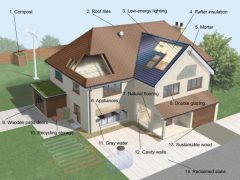When assessing the green credentials of your house, or investigating where green improvements could be introduced, there are a number of areas to explore. Many green solutions are relatively straightforward, while some will involve major upheaval and may be more suited to a new-build project than a retrospective fit. Use the information given here as a link to more detailed analysis later in the book. You will see that there are greener options for nearly all aspects of DIY.
There are advantages and disadvantages with any building technique or material, and eco-friendly options are no different. If possible, it is always important to substantiate a manufacturer’s claims with hard evidence. As in any aspect of life, manufacturers are concerned primarily with selling goods, so it is necessary to compare products, research different ideas, and make sure they meet your own needs. The areas covered here deal with most aspects of what is currently available in terms of making your home a greener place to live. Using the relevant page references, you can refer to various parts of the book for more in-depth information — and to learn how to carry out green projects yourself.
The Pay-Off With Green Living
If all houses featured many of these ideas, the energy usage of the population as a whole would be significantly reduced. However, the initial financial outlay must always be considered. With low-energy lightbulbs, for example, the initial cost is low, so the pay-off is fast—in terms of saving both energy and money. But with larger, more expensive projects, such as installing solar panels, the energy-saving pay-off may be quick, but it will take far longer to recoup the initial costs. The best advice is to address the key options first (insulate well, use low-energy electrical goods, and recycle), leaving the more complex projects to form part of the decision-making process of any future home improvements.
1. Compost
Making compost is the ultimate expression of green living — turn your food scraps and yard debris into fertilzer.
2. Recycled Roof Tiles
Consider using reclaimed clay or stone tiles, or slates.
3. Low-Energy Lighting
A small investment can have a large impact on saving electricity.
4. Rafter Attic Insulation
In a lived-in roof space, ensure the ceiling is insulated sufficiently.
5. Mortar
For brick or stone homes, lime mortars are far greener than those that are cement-based.
6. Appliances
Be sure to choose energy-efficient models.
7. Natural Flooring
Choose flooring from sustainable sources or materials such as bamboo and cork.
8. Double Glazing
Double or even triple glazed windows will always make your home more energy efficien.
9. Wooden Patio Doors
Double-glazed windows need not be UPVC or aluminum. Wood is a greener option and will last just as long if well it is well-maintained.
10. Recycling System
A good system of sorting materials for recycling is essential for every home.
11. Gray Water
As well as using collected rainwater in the home, you can also recycle water from sinks, baths, and showers.
12. Insulated Walls
Well-insulated exterior walls can help to further reduce your energy requirements.
13. Sustainable Wood
Make sure that any wood you use in your home comes from a sustainable source.
14. Reclaimed Slabs
It is not always necessary to buy new — consider using reclaimed bricks and patio pavers.

